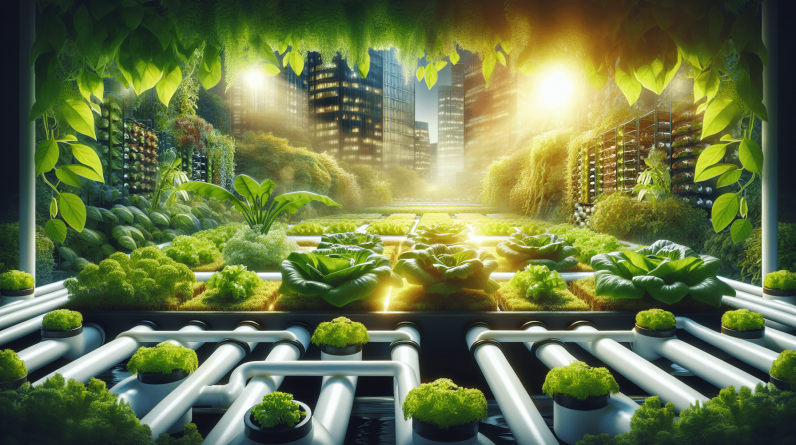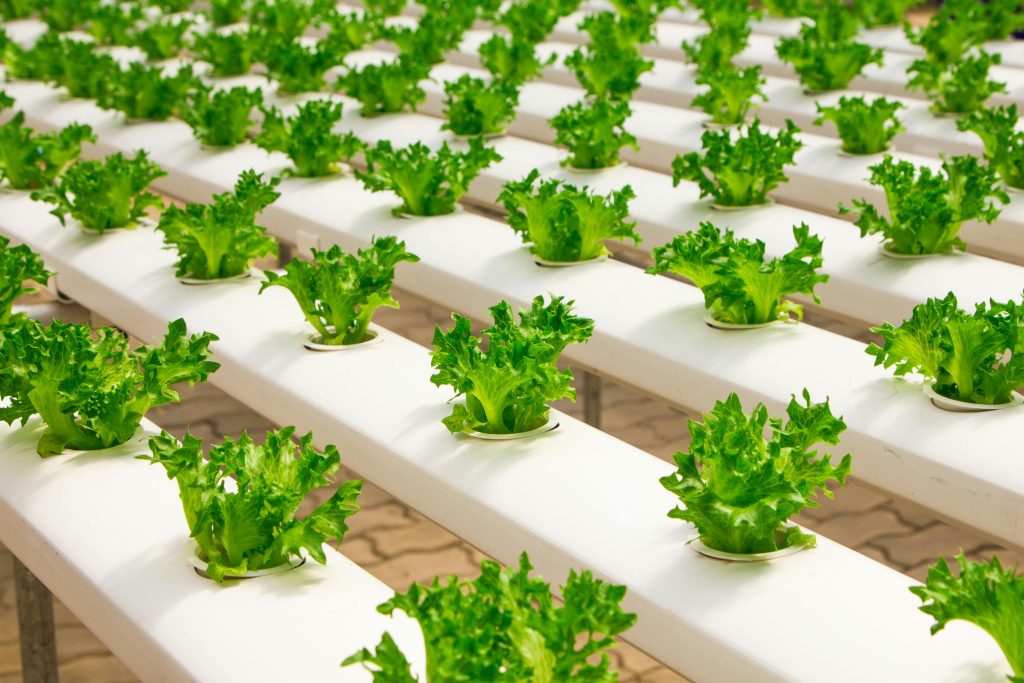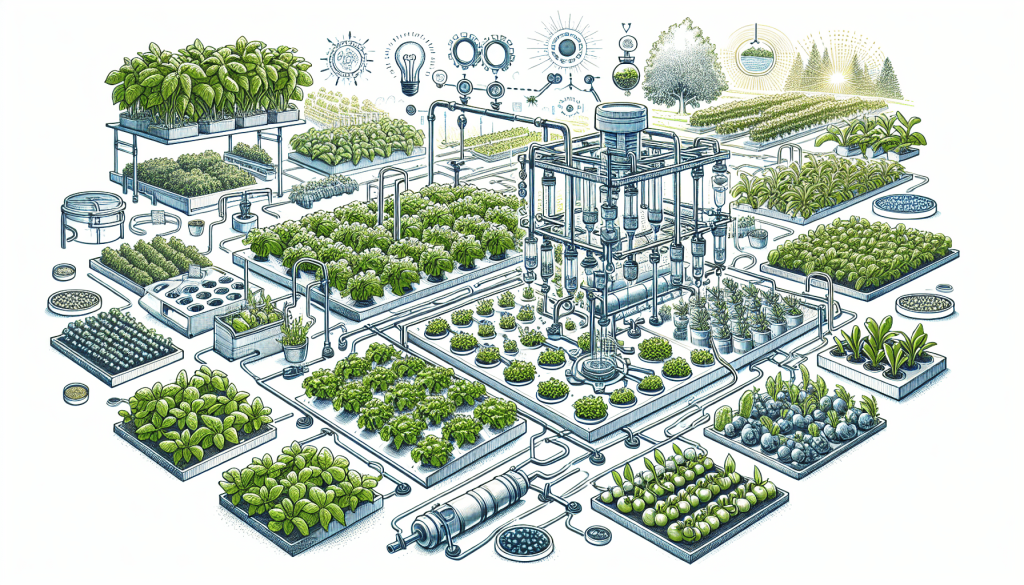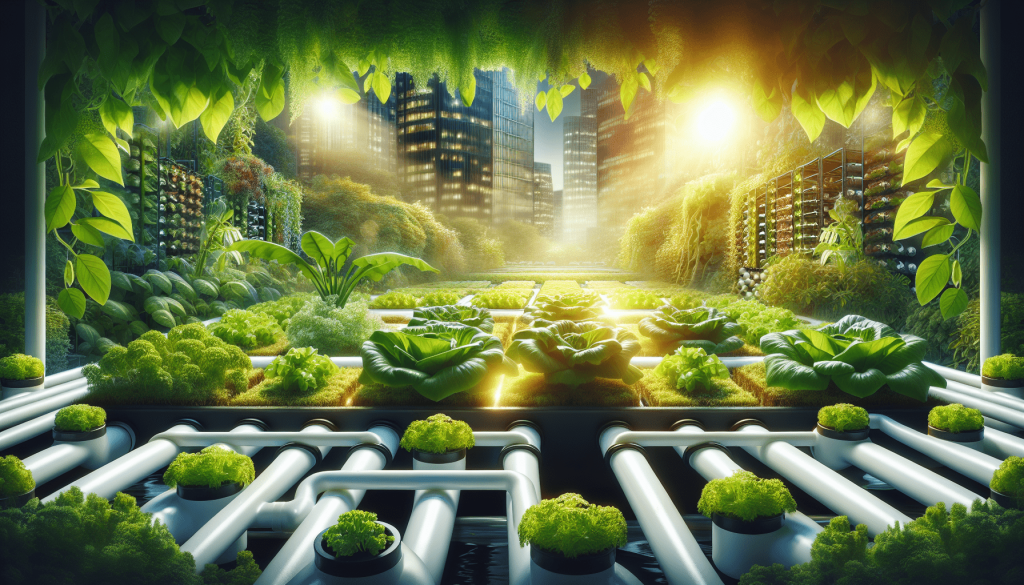
Imagine a world where you can grow an abundance of fresh vegetables, fruits, and herbs all year round, without the need for soil or traditional gardening methods. Welcome to the world of hydroponic gardening! In this article, you will discover a variety of ingenious techniques that can help you achieve maximum yield in your hydroponic garden. From nutrient solutions to lighting setups and plant selection, we will explore the key elements that contribute to the success of this innovative and efficient way of growing plants. So, whether you are a seasoned gardener or just starting out, get ready to unlock the secrets of hydroponic gardening and reap the rewards of bountiful harvests.

Choosing the Right Hydroponic System
Hydroponic gardening is a soil-less method of cultivating plants that offers numerous benefits. It allows you to grow plants indoors, regardless of the season or climate. With the right hydroponic system, you can maximize your plant yields and minimize water usage. When choosing a hydroponic system, several factors should be taken into consideration to ensure the best results for your specific needs.
The first factor to consider is the space available for your hydroponic garden. If you have limited space, a compact and vertical system like the nutrient film technique (NFT) or the aeroponic system may be suitable. However, if you have more space to spare, larger systems like the ebb and flow or the deep water culture (DWC) systems may be more appropriate.
Another important factor to consider is the level of expertise and time commitment you are willing to dedicate to your hydroponic garden. Some systems require more advanced knowledge and maintenance than others. For beginners, simpler systems like the wick system or the Kratky method might be a good starting point.
The type of plants you wish to grow also plays a role in determining the right hydroponic system. Different systems are better suited for specific plant types. For example, NFT systems are ideal for growing leafy greens and herbs, while DWC systems are better for larger plants like tomatoes or cucumbers. Consider the specific nutrient and water requirements of the plants you want to grow when choosing a system.
Lastly, your budget should also be taken into account. Hydroponic systems can vary greatly in cost, depending on their complexity and size. Consider your budget constraints and choose a system that offers the best value for your money.
Ensuring Proper Nutrient Balance
In hydroponic gardening, it is essential to understand the essential nutrients required for plant growth. These nutrients are divided into two main categories: macronutrients and micronutrients. Macronutrients include nitrogen, phosphorus, and potassium, while micronutrients encompass elements like iron, manganese, and zinc.
Maintaining the correct nutrient balance in your hydroponic system is crucial for healthy plant growth. Too little or too much of any nutrient can lead to nutrient deficiencies or toxicities, both of which can hinder plant growth and reduce yields. Regular monitoring and adjustment of nutrient levels are necessary to ensure optimal plant health.
There are several methods for testing and adjusting nutrient levels in a hydroponic system. The most common method is through the use of electrical conductivity (EC) and pH meters. EC meters measure the electrical conductivity of the nutrient solution, which indicates the concentration of dissolved salts. pH meters measure the acidity or alkalinity of the nutrient solution. By regularly monitoring these parameters and adjusting the nutrient solution accordingly, you can maintain the proper nutrient balance.
Common nutrient deficiencies include yellowing leaves (indicative of nitrogen deficiency), necrosis or brown spots (indicative of calcium or magnesium deficiency), and stunted growth (indicative of phosphorus deficiency). If you notice any of these symptoms, it is important to address the nutrient deficiency promptly. This can be done by adjusting the nutrient solution or supplementing it with specific nutrient additives.
Creating the Ideal Environment for Maximum Yield
To achieve maximum yield in your hydroponic garden, creating and maintaining the ideal environment for your plants is crucial. Temperature and humidity levels play a significant role in plant growth and should be carefully regulated.
Most plants thrive in temperatures between 65 to 75°F (18 to 24°C). However, different plants have varying temperature requirements at different stages of growth. Seedlings generally require slightly higher temperatures, while mature plants may tolerate slightly lower temperatures. It is important to provide adequate heating or cooling systems to maintain a consistent temperature range for optimal growth.
Humidity levels also need to be controlled to prevent the development of mold and fungal diseases. The ideal humidity range for most plants is between 50% to 70%. However, during the flowering or fruiting stage, lower humidity levels may be necessary to prevent issues like bud rot. Proper air circulation and ventilation can help regulate humidity levels and prevent stagnant air.
Proper lighting is another crucial aspect of creating the ideal environment for maximum yield. Different stages of plant growth require different types and intensities of light. Seedlings and young plants generally need higher levels of blue light to support vegetative growth, while flowering and fruiting plants require more red light. Utilizing full-spectrum LED grow lights can provide a balanced light spectrum for all stages of plant growth.
In addition to lighting, air circulation and ventilation are equally important for plant growth. Adequate air circulation helps prevent the development of mold, improves CO2 absorption, and strengthens plant stems. Ventilation systems, such as fans or air pumps, can help maintain a steady flow of fresh air throughout the growing area.
Monitoring and controlling pH levels in your hydroponic system is also crucial for maximum yield. Most plants prefer a slightly acidic pH range of 5.5 to 6.5. Fluctuations in pH can affect nutrient absorption and lead to nutrient deficiencies or toxicities. Regularly testing the pH of your nutrient solution and adjusting it within the optimal range will ensure that your plants can uptake nutrients effectively.
Choosing the Right Growing Medium
In hydroponics, the growing medium serves as a support structure for the plants and allows for the exchange of water and nutrients. There are various types of growing mediums available, each with its own set of benefits and drawbacks.
Some commonly used growing mediums in hydroponics include sterile soilless mixes, such as perlite or vermiculite, coconut coir, expanded clay pebbles, and rockwool. Each medium offers different water-holding capacities, aeration properties, and root support.
When choosing a growing medium, consider factors such as water retention capacity, pH neutrality, re-usability, and availability. Some mediums are more suitable for certain hydroponic systems. For example, expanded clay pebbles are commonly used in flood and drain or ebb and flow systems, while rockwool is often used in NFT or drip systems.
It is important to properly prepare and maintain the selected growing medium to ensure optimal plant growth. Depending on the medium, this may involve soaking, rinsing, or buffering with the appropriate nutrient solution. Regular monitoring of the moisture levels and pH of the medium will help prevent issues like waterlogging or nutrient imbalances.

Understanding Water Quality and Management
Water quality is a critical factor in hydroponic gardening. Since plants receive all their nutrients from the water, it is essential to use quality water to prevent nutrient deficiencies or toxicities.
Testing the water used in your hydroponic system is necessary to assess its suitability for plant growth. Basic water quality tests can measure parameters such as pH, electrical conductivity, and total dissolved solids (TDS). These tests will give you an idea of the water’s natural composition and whether any adjustments or treatments are necessary.
Water treatments may be required to adjust pH levels, remove chlorine or chloramines, or address high levels of minerals or contaminants. Common treatment methods include pH adjustment using acids or bases, filtration systems, or the use of water conditioners.
Proper water management techniques are crucial for maintaining the health of your hydroponic system. It is important to monitor and maintain the water levels in your reservoir, ensuring that there is enough water for the plants to uptake but not so much that it leads to waterlogged growing mediums. Regularly replenishing and replacing the nutrient solution and adjusting nutrient levels will help prevent nutrient imbalances.
Implementing Effective Nutrient Delivery Systems
The delivery of nutrients to plants in a hydroponic system can be achieved through various methods. Understanding the different nutrient delivery systems and their benefits is crucial for maximizing yield and preventing nutrient deficiencies.
One popular nutrient delivery system is the nutrient film technique (NFT), where a thin film of nutrient-rich water flows over the roots of the plants. NFT systems are known for their efficient use of water and nutrients and are well-suited for growing leafy greens and herbs.
Ebb and flow systems, also known as flood and drain systems, rely on periodically flooding the growing medium with nutrient-rich water and then draining it away. This flooding and draining cycle ensure good oxygenation of the roots and can be used for a wide range of plants.
Drip systems use drip emitters to deliver a controlled amount of nutrient solution directly to the base of each plant. This method is widely used due to its ease of implementation and provides precise nutrient delivery for individual plants.
Each nutrient delivery system has its own benefits and considerations. Factors to consider include water and nutrient usage, complexity of setup and maintenance, and the specific requirements of the plants you are growing. Choose a system that aligns with your needs and goals.
To ensure efficient nutrient delivery and prevent clogs, it is important to clean and flush the delivery system regularly. Flushing the system with clean water or using specialized cleaning solutions can help remove any mineral buildup or organic matter that could interfere with nutrient flow.

Managing Pest and Disease Control
Pests and diseases can pose significant challenges in hydroponic gardening. Identifying common pests and diseases and implementing preventive measures are essential for maintaining healthy plants.
Some common pests encountered in hydroponics include aphids, whiteflies, spider mites, and fungus gnats. Regularly inspecting your plants for signs of pest infestation and promptly addressing any issues is crucial. Integrated pest management (IPM) techniques, such as the use of beneficial insects or the application of organic pest control solutions, can help manage pest populations without resorting to harmful chemicals.
Preventive measures, such as maintaining a clean and sterile growing environment, practicing good hygiene, and regularly sanitizing equipment, can greatly reduce the risk of pest infestation and the spread of diseases. Additionally, providing proper air circulation, keeping humidity levels in check, and avoiding over-watering can help prevent issues like mold or fungal diseases.
Non-toxic and organic solutions exist for pest and disease management. These can include neem oil, insecticidal soaps, and biological controls like ladybugs or predatory mites. Using these methods will help protect your plants without harming the environment or compromising the safety of your produce.
Pruning and Training Techniques for Optimal Growth
Pruning and training techniques are important tools for optimizing plant growth and maximizing yields in hydroponic systems. Pruning involves removing specific parts of the plant, such as leaves or branches, to promote better airflow, light penetration, and overall plant health.
Different plants require different pruning techniques. For example, leafy greens like lettuce benefit from regular harvesting of outer leaves, while vining plants like tomatoes or cucumbers require the removal of lower leaves to direct energy towards fruit production. Research the specific pruning techniques for the plants you are growing to ensure optimal results.
Training methods, such as trellising or staking, can help enhance plant structure and support heavy or vining crops. By providing support and directing growth, training techniques can increase the efficiency of space utilization and improve light penetration.
Practical tips for effective pruning and training include using sharp and clean tools to prevent the spread of diseases, taking care not to injure the main stem or root system, and regularly monitoring the plants for any signs of stress or overgrowth. Regular pruning and training will help promote better plant health, prevent overcrowding, and increase overall productivity.

Monitoring and Maintaining System Health
Regular monitoring and maintenance of your hydroponic system are crucial for its long-term success. By conducting regular system inspections and performing routine maintenance tasks, you can identify and address any issues before they become major problems.
Regularly inspecting your system involves checking for leaks, clogs, or any signs of wear and tear. Ensure that all connections are secure and that the water and nutrient solution levels are within the appropriate range. Monitoring environmental conditions such as temperature, humidity, and light levels will help you identify any deviations from the ideal range.
Identifying and addressing common system issues is an important part of system maintenance. Some common issues include nutrient imbalances, pH fluctuations, pump malfunctions, or root diseases. By being proactive and addressing these issues promptly, you can prevent further damage to your plants and ensure their continued growth and health.
Cleaning and disinfection procedures should be a regular part of your maintenance routine. This includes cleaning and sanitizing the reservoir, removing any debris or mineral buildup, and sterilizing any equipment used in your hydroponic system. Regular cleaning will help prevent the spread of diseases, maintain nutrient solution quality, and extend the lifespan of your equipment.
If you encounter any system malfunctions or issues, troubleshooting tips can help you identify the cause and find a solution. Common troubleshooting steps include checking for power supply issues, inspecting the pump or irrigation system, and re-calibrating meters or sensors. Consulting with experts or fellow hydroponic gardeners can provide valuable insights and support in solving any system challenges.
Harvesting and Post-Harvest Handling Techniques
Determining the right time for harvest is crucial to ensure optimal freshness and flavor in your hydroponically grown produce. Harvesting too early or too late can result in bland or overripe produce.
Different plants have different indicators of readiness for harvest. Leafy greens, for example, can be harvested as soon as the outer leaves are large enough to be consumed. On the other hand, fruits like tomatoes or peppers should be allowed to fully ripen on the plant before harvesting.
Proper harvesting techniques are essential to avoid damaging the plants or introducing contaminants. Using clean and sharp tools, such as scissors or pruning shears, will help ensure clean cuts and minimize damage to the plant. Harvesting during cooler parts of the day will also help preserve the quality and shelf life of the produce.
Post-harvest handling plays a crucial role in maintaining the quality and freshness of your hydroponically grown produce. Immediately after harvest, it is important to clean the produce, removing any visible dirt or debris. Depending on the type of produce, some items may require additional steps such as blanching or icing to preserve freshness.
Storage and preservation methods will vary depending on the specific produce. Some produce, like leafy greens, are best stored in moisture-absorbing bags or containers in the refrigerator. Others, like root vegetables, can be stored in a cool and dark location. It is important to research the specific storage requirements of the produce you are growing to maximize shelf life and minimize spoilage.
By following proper harvesting and post-harvest handling techniques, you can ensure that your hydroponic produce retains its quality, flavor, and nutritional value for a longer period of time.

Related Content
- The Ultimate Guide to 10 Effective Hydroponic Lettuce Growing Strategies for 2025
- The Ultimate Guide to Hydroponic Growing for Beginners: 7 Effective Tips for 2025
- Can You Put Seeds Straight Into Hydroponics?
- How to Set Up a Vertical Hydroponic Garden
- What Makes Hydroponic Systems the Future of Gardening?







